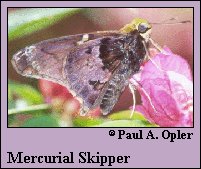 |
 

 |



Mercurial Skipper (Proteides mercurius [Fabricius])
Wing span: 2 1/4 - 2 3/4 inches (5.8 - 7 cm).
Identification: Head and thorax are bright orange above; forewings are elongate. Upperside of wings is brown with golden orange at the bases. Underside is chestnut brown with white frosting on outer edges; center of hindwing has an indistinct white mark.
Life history: Adults bask with their wings spread open. Males perch to find females. Caterpillars rest in leaf shelters and come out at night to eat leaves.
Flight: April-May in southern Florida, April-October in South Texas, all year in Mexico.
Caterpillar hosts: Tree and vine legumes including senna (Cassia), cow pea (Vigna), and Muellera.
Adult food: Flower nectar.
Habitat: Near streams in lowland tropical forests, particularly in edges and openings.
Range: Argentina north through Central America to Mexico and the West Indies. Strays to Florida, Louisiana, and Texas.
Conservation: Not usually required.
The Nature Conservancy Global Rank: G5 - Demonstrably secure globally, though it may be quite rare in parts of its range, especially at the periphery.
Management needs: None reported.
References:
Opler, P. A. and V. Malikul. 1992. A field guide to eastern butterflies. Peterson
field guide #4. Houghton-Mifflin Co., Boston. 396 pages, 48 color plates.
Scott, J. A. 1986. The butterflies of North America. Stanford University Press,
Stanford, Calif. 583 pages, 64 color plates.
Author: Jane M. Struttmann

